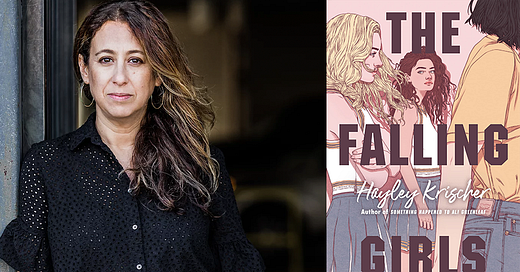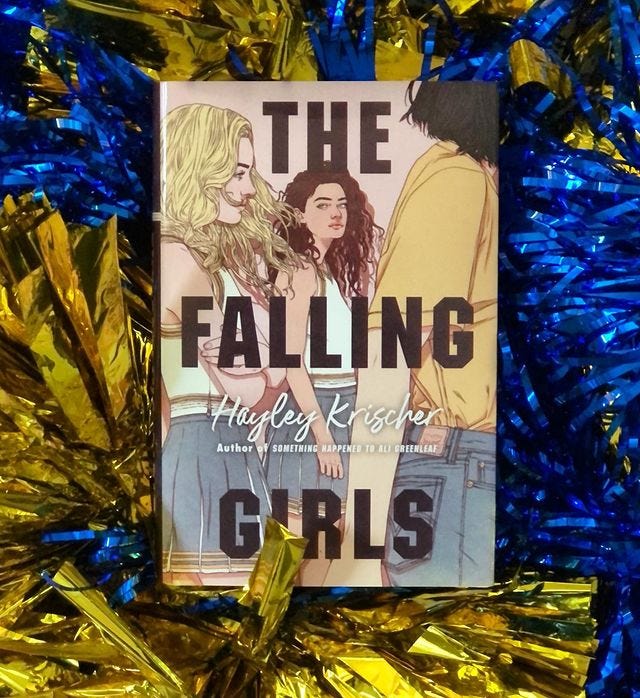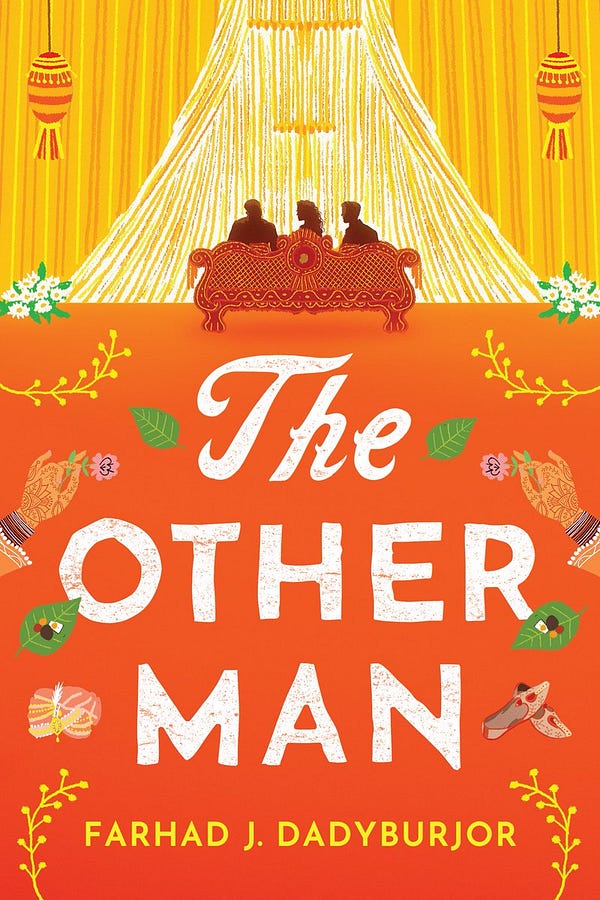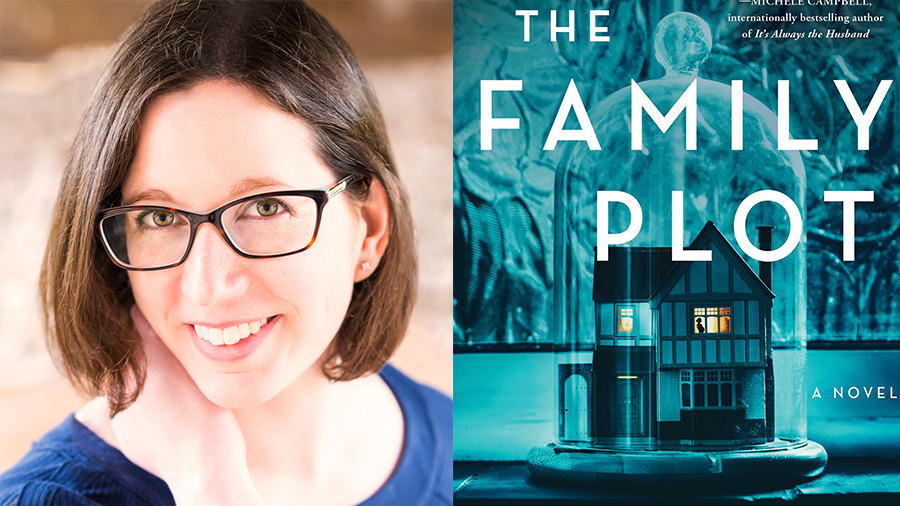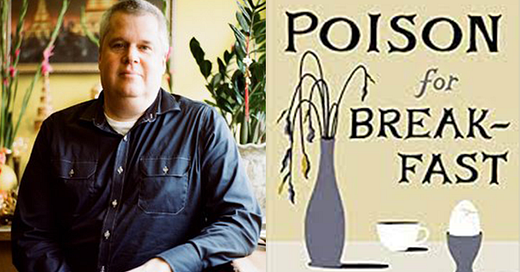How Hayley Krischer Sits Down & Writes
'The Falling Girls' is a friendships story with life or death stakes.
Shade and Jadis are everything to each other. They share clothes, toothbrushes, and even matching stick-and-poke tattoos. So when Shade unexpectedly joins the cheerleading team, Jadis can hardly recognize who her best friend is becoming.
Shade loves the idea of falling into a group of girls; she loves the discipline it takes to push her body to the limits alongside these athletes. Most of all, Shade finds herself drawn to The Three Chloes—the insufferable trio that rules the squad—including the enigmatic cheer captain whose dark side is as compelling as it is alarming.
Jadis won’t give Shade up so easily, though, and the pull between her old best friend and her new teammates takes a toll on Shade as she tries to forge her own path. So when one of the cheerleaders dies under mysterious circumstances, Shade is determined to get to the bottom of her death. Because she knows Jadis—and if her friend is responsible, doesn’t that mean she is, too?
In this compelling, nuanced exploration of the layered, intoxicating relationships between teen girls, and all the darkness and light that exists between them, novelist Hayley Krischer weaves a story of loss and betrayal, and the deep reverberations felt at a friendship’s breaking point.
The Falling Girls is perfect for fans of Jessica Goodman, Megan Abbott and Kathleen Glasgow.
We got to chat with Hayley Krischer about all-consuming friendships, shitty first drafts, and one valuable writing lesson.
Q: Where do you like to write the most?
At my desk with my giant 90-pound dog, Trudy, under my feet.
Q: When do you like to write the most?
I love writing first thing in the morning with a cup of coffee when everyone in my house is still asleep.
Q: When it comes to drafting, do you prefer writing on a computer or freehand?
Writing on a computer, but I still sometimes write freehand in a journal. Also, I always print out multiple pages of my book and do edits that way.
Q: Are you more of a plotter or pantser?
I’m a plotter. But I’m the kind of plotter who changes the plot many times as she goes. So maybe I’m a plotter panster?
Q: Stephen King has a great line in On Writing that says “the scariest moment is always right before you start. After that, things can only get better.” That scary pre-start moment often inspires procrastination in writers. Suddenly, you have to clean your entire house, do the laundry and play Candy Crush for an hour before you can actually start writing. Is there anything you need to do before you can actually sit down and work?
I’ll usually re-read a book to get inspired by the vibe of what I’m trying to achieve on paper. I find that helps me with any kind of anxiety or writer’s block. Oscar Wilde said that “Imitation is the sincerest form of flattery…” so I guess that’s what I do!
Q: Do you listen to music while you write? If so, what music? Is your choice of music inspired by the project you’re working on?
Sometimes. It usually has to be something I know pretty well so that it doesn’t distract me.
Q: Some writers believe you have to write every single day. Is that true of your process? How often do you write/how long for each session?
I used to believe that. And I was diligent about it. But I don’t believe that anymore. I think that reading oils your brain as well. Sometimes I’ll write for hours. Sometimes I’ll write for 30 minutes. When I’m working on a project and want to finish it and have goals or deadlines around it, I try to write minimum 1000 words a day. Scrivener has a little bell that goes off when I reach 1000 so it gives me that satisfaction.
Q: What’s one piece of advice you’d give an aspiring author?
Don’t give up. Writing is beautiful, writing is everything, writing is how I breathe. Writing is also like feeling like you’re a hot dog being boiled alive. Rejections are part of the writing process. You have to go through a lot of feeling like that boiled hot dog before you get to the rewards.
Q: Where do you normally find story inspiration?
Since I’m also a journalist, I think I naturally find inspiration in articles that I’ve read about. My two books are both sort of “ripped from the headlines.” I’m fascinated by what happens to people in real life.
Q: Why did you decide to center this story about intense female friendship around a high school cheerleading squad?
I read about the murder of Skylar Neese who was a 16-year-old girl in West Virginia who was murdered by her two best friends. I really couldn’t imagine what got them to that point and I was fascinated by the three of them as a trio before the murder. What happened leading up to the murder? Did they know how toxic the friendship was? Were they really happy with each other in that friendship? I wanted to play with that idea in The Falling Girls so that I could pick apart what it would look like to really see a friendship breakup. The cheerleading squad came after. I was a very bad cheerleader in high school and was sort of obsessed with the idea of a girl who was an outsider wanting to find agency in her body and herself through a high-risk mostly female sport like cheer.
Q: Shade and Jadis are the kind of friends that seem to have trouble knowing where one of them starts and the other ends. When crafting their characters, how did you balance their undeniable tether to one another while also making them their own distinct people?
I knew they were both outsiders and that they liked being outsiders. Well, Jadis liked it. Shade, not so much. I wanted to show their closeness because that was the kind of closeness that I had with my friends in high school. We were always just on top of each other, sharing everything, no end, no beginning. But they also needed to be different. As I wrote the story, I filled in the details about their differences and really picked apart the characters. That’s the fun part.
Q: What made you want to explore the kind of co-dependency Shade and Jadis experienced in this book?
Well, it goes back to that Skylar Neese case. I think that if you’re going to put someone in a situation where you would suspect her as a murderer, you’d have to see how close she was to her best friend to do that. I wanted the stakes to be so high for Shade and Jadis so that the break would feel like it could push Jadis to killing someone else. In high school those emotions are all heightened. You sometimes did want to kill someone! So that co-dependency was part of exploring the friendship. Who were they if they weren’t together? High school girls especially lose themselves in their friendships — sometimes that co-dependency feels good because you have “your person.” But it’s unhealthy as well.
Q; Did you find yourself drawn to Shade or Jadis (or even the Chloes) more than the other while writing?
I loved the Three Chloes because Heathers was my favorite movie when I was a senior in high school. It was like a revelation to me. It gave permission to girls to be very ugly. My initial drafting of the Three Chloes was much more vicious and raw, but I pulled back on it because making them complete monsters took away from the friendship breakup story. I wanted Shade to be able to want to be friends with Chloe Orbach. I knew Shade was too together to be attracted to someone who was a total monster. So I needed to make all of them somewhat likable.
Q: In addition to Shade and Jadis' complicated relationship, Falling Girls explores a number of scenarios—toxic family dynamics, drug abuse, death—how did you navigate all these sensitive topics while drafting?
I tend to write write write and get it all down. Then I can see what I’ve got. I’m very much of the Anne Lamott “shitty first draft.” Meaning, write until you get to the end. No looking back. All of a sudden, as I was writing about these very complicated girls and I wanted to see what their family of origin was about. Why were they the way they were? Who were their moms? I’m a mom of a teenager so it’s impossible for me not to be influenced by my own parenting and some of the parents that I see around my town. You have to navigate them like with any other topic. I try to be as honest and as open as I can be to the situation even if it’s thorny and uncomfortable, like toxic family members or drugs. I want to really see the difficult side and not gloss over it.
Q: You received your MFA from Lesley University (as did we in 2020)--what is something you learned about your craft while working towards your degree?
That not every one is going to like your work, and guess what? They don’t have to! For me, my most important critic is number one: me. Then I have a few readers that I implicitly trust, my editor and my agent. At the end of the day you have to be the most fanatic about your work and work with people who believe in you.
Grab your copy of Three Pianos from bookshop.org, IndieBound, or Barnes & Noble. Happy reading!
Sit Down and Write is brought to you by Emily Lee and Cassie Stossel. For more author interviews like this one straight to your inbox, subscribe below!



